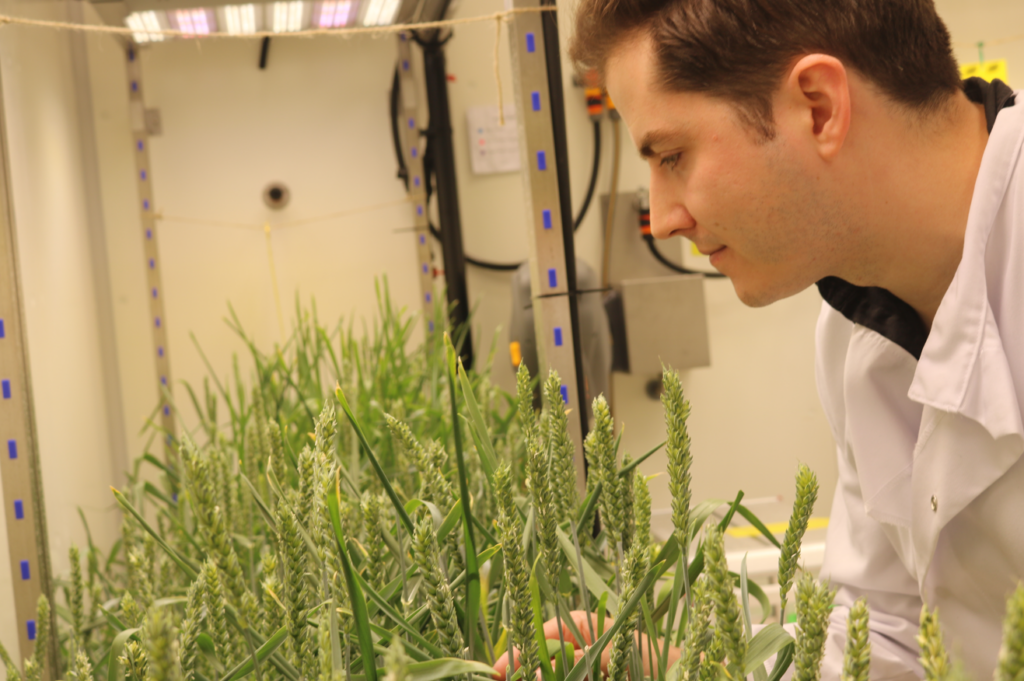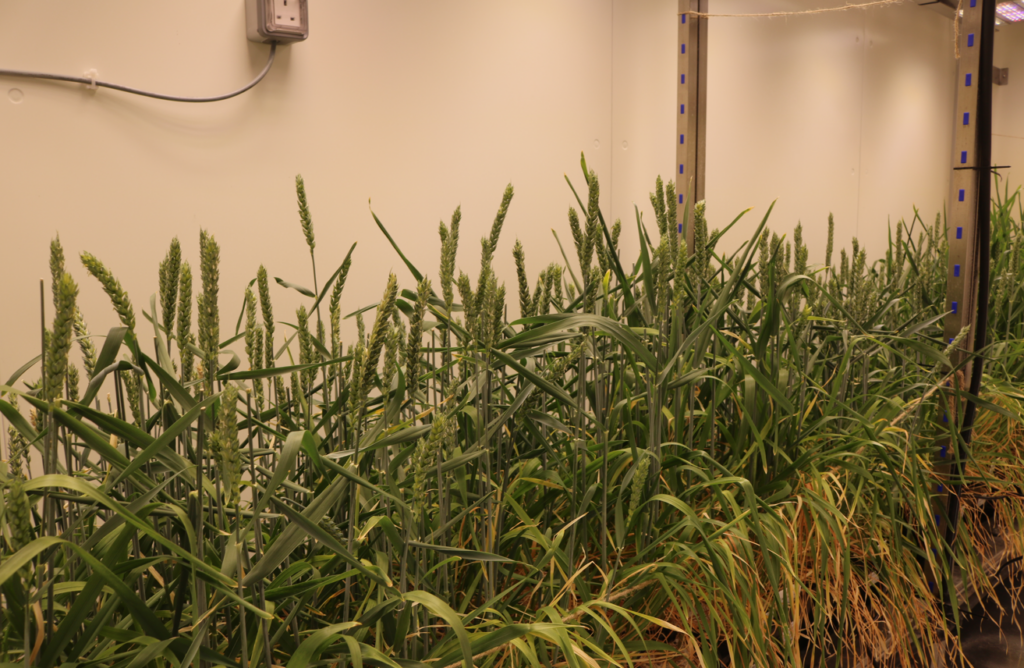Wild plants could hold the genetic key to a step change in productivity across major agricultural crops. Tech Farmer visits the labs of a new start-up that’s sifting through the genomes.
Ross Hendron looks up at the ear of the wheat plant he has just pulled down off the shelf of the growth room.
“At the moment it’s just one plant,” he says, and turns his gaze to the dozens of companion plants sitting on the shelf under the bright LEDs. “We have to pick which of these will work best, and we won’t know for sure until we have enough seed to test them in the field. But the lab tests have proved promising.”
What Ross holds in his hand could represent a step change in yield that is beyond the capability of any wheat currently under cultivation anywhere in the world. The variety is Cadenza that has been edited at precise points in its genome to improve its photosynthetic ability.
A subtle tweak can make a step change to how efficiently a plant behaves.
But just because current wheats don’t have the ability to do this themselves, that doesn’t mean it’s not in their nature. According to Ross and his team at Wild Bioscience, a spin-out biotech firm from Oxford University, it may be a case of waking up a gene already present in the wheat genome.
“Wheat’s been cultivated as a crop for about 10,000 years, but in evolutionary terms, that’s nothing,” he says. “There are many wild plants that have dealt with climate shocks that cultivated plants have never even experienced on a farm. But if you look closely at the genome, they all share a similar genetic hardware.”

This insight originated in the lab of Professor Steve Kelly, where Ross joined as a PhD student in 2016. Steve’s lab develops and uses computational approaches to understand the genetic basis for how plants work. His group uses these insights to investigate fundamental questions in the evolution of plants, such as how photosynthetic pathways have evolved, and why some plants grow faster than others.
It’s this approach that the team at Wild Bioscience have been exploring since Ross and Steve founded the business less than three years ago. £12 million of venture capital has sped it on its way, and now there are offices, growth rooms, labs and a team of 20 staff in Milton Park, just a few miles from Oxford, where the vision began.
“But it’s a challenge – the genomes of wild plants generally haven’t been mapped,” notes Ross. “Wheat has, but it’s a complex genome of 17 billion letters. However, if you look closely, there are some plants that have evolved the ability to turn on certain characteristics. Crop plants have much of the same genomic architecture, but haven’t inherited these characteristics.”
It’s these that give a cactus its ability to survive in desert conditions, for example. Find the genetic secrets to survival in these harsh environments and you have the potential to bring about a transformation, he points out. “A subtle tweak can make a step change to how efficiently a plant behaves. You then use machine learning to target that.”

Ross and Steve had been looking closely at the signalling molecules that are used to tell a cell to develop chloroplasts. While all plants use these to drive photosynthesis in certain cells, such as in the leaf and stem, many different wild plant species have evolved the ability to turn these on in specific cells – an ability wheat currently doesn’t share. “But the tweak has to be precise – get it wrong and you get chloroplasts in roots and flowers,” notes Ross.
It was during Ross’ PhD research that he and Steve first managed to put this theory into practice. “The first plant I transformed was Arabidopsis – a type of plant scientists often use because we know so much about the genome. I made many different transformations, and I guess the seminal moment for both of us was seeing them develop – there were some that just stood out in the greenhouse as significantly ahead of the rest in terms of their growth.”
Since then, the work of Wild Bioscience has focused on developing interesting genes and characteristics in widely grown broad-acre crops, chiefly soya, maize and wheat. Most of the novel prototype plants are GMOs, genetically modified with a piece of plant DNA. This has proven the technology, and there are one or two crops, notably soya, that have now progressed as far as field trials grown in South America. Tight regulations for growing GMOs in the UK and EU severely restrict putting the crops in the field here, and they would be unlikely to be commercially grown.

But the team is now working on editing the genome of farmed crops to achieve the same transformative leap, using new genomic techniques (NGT). Also called precision-bred organisms (PBO), these are plants where scientists have made a small and precise edit to its DNA that could have happened naturally. Legislation passed in 2023 has now allowed these crops to be grown in the field in England without the restrictive GMO regulations, with similar laws currently passing through the European Parliament.
That means progeny of the wheat plant that Ross carefully places back on the shelf can come into English farmers’ fields without restrictions. “It’s part of a programme we’ve branded Wild Solar, which encompasses the changes in photosynthetic efficiency,” explains Ross as he shuts the door of the growth room, leads the way to another door and opens its hatch. Peering through the glass reveals more brightly lit plants, this time soya.
Alongside Wild Solar, the company has recently introduced Wild Carbon, which uses the roots of crop plants to create what Ross describes as a “revolution” in long-term carbon sequestration. “Plants are masters of moving CO₂ around,” he enthuses, his face lit up as he looks on his soya plants through the window.
“This is mostly to do with producing sugars, and you don’t want to mess with that process as it affects yield.”

Ross explains that most of the CO₂ taken up by plants is drawn into cells in the leaf and involved in photosynthesis. Wild Carbon is designed to bypass photosynthesis and store atmospheric CO₂ via the roots directly into the soil where it will stay locked up. “The potential of this technology is vast, as it could turn farmland into the world’s largest CO₂ storage facility without effecting crop yield or changing land use.”
The Wild Bioscience team believe they may have found the genes that enable this and sequences of DNA have now been transferred into some of the lines in this very room. “These GM soya plants look promising,” says Ross as he closes the hatch.
“But it doesn’t have to be GM. The gene we’ve brought in is controlled by a promoter sequence. We can edit the plant to turn on and off a different promoter sequence to act on the exact same gene that soya already has in its genome, and we believe that will have a similar effect.”
And it doesn’t have to be soya. In the early stages of exploring a genetic alteration, when trying to establish the phenotypical change that results, soya is actually harder than wheat to edit, he continues. But wheat is hexaploid, so there’s additional work needed to determine how the appropriate gene should be edited over the three copies of its genome.
“Here we’re looking at a gain-of-function, so we believe we only have to turn on one gene in one genome to get the gain. What’s exciting, though, is that this means there are many different ways we can explore how to combine the benefits of these approaches to boost both yield and carbon removal in the same plant.”
The Wild Carbon work is some way off application in the field, particularly for NGT lines. But Ross is confident the Wild Solar wheat is almost ready, and just needs to be multiplied up. “One of the big challenges we have as scientists is to replicate the same changes we see in the lab out in the field,” he notes.

“Field trials are a crucial step in seeing how these novel plants interact with the environment and the agronomy applied to them on commercial farms. We’re at the very beginning of our journey there.”
This is where farmers can help. As soon as enough material is available, agronomy programmes will need to be shaped and soil and field conditions explored to get the best from the novel crops.
Ross believes this will also address the reservation some people have for the technology. “Once these crops get out into the field and farmers can see the benefits, I hope it will demonstrate the impact precision breeding can have.
“There are many societal benefits we can deliver with these novel methods that simply cannot be achieved through traditional plant breeding. Once the products are available to farmers and consumers, I think the narrative will change and this will create more choice for farmers.”
As a scientist Ross is also keen to get feedback from farmers interested in growing NGTs. “I know there are many farmers who are excited about new technology, but what motivates those who are adept with a pipette may be different to what drives those who tend the land. I think there are passion points we share, and it’s these we can explore once these novel crops are in farmers’ fields and showing their worth,” he concludes.




